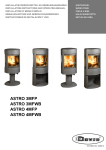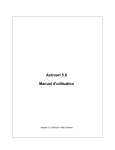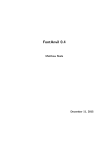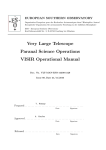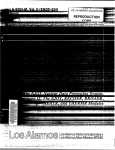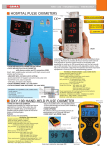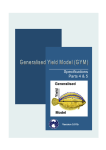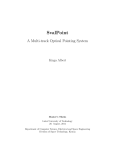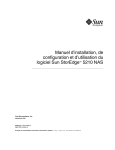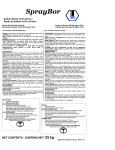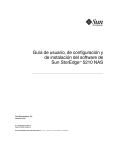Download Unofficial guide to AstroArt`s script commands
Transcript
Unofficial guide to AstroArt’s script commands
Prologue
Since using the CCD camera for my astronomical observation my reference software for the recovery and
processing of images has always been AstroArt. Naturally over the years I have found to handle other
software of this type, certainly some very good, and although my limited experience, they not allow me to say
too much in benchmarking, I think for me the unbeatable immediacy with which the AstroArt user’s are able
to use this software almost immediately. A very friendly user interface, combined with the scientific rigor of
the algorithms used has made one of the leading software in the field of amateur astronomy. The advent of
version 3.0 and higher, with command script has further expanded its potential, so that it is possible (if
provided with the necessary hardware) to perform automated tracking and recovery, which greatly facilitate
the conduct of the observing sessions.
Anyone who had a minimum of programming experience also knows how difficult and tedious write and
especially keep updated the user manual. Therefore it happens that the manuals available is not always up
to date with respect to the evolution of software, but also that some features are not always explained
sufficiently extensive for the average users.
This guide seeks to illustrate some commands for AstroArt ‘s scripts that, in the user manual are poorly
documented or even at all. As the title suggests this is an unofficial guide and although parts of it modeled on
the original user manual does not purport to replace it, but rather as an informal integration with regard to the
commands of the scripting of this magnificent software.
The commands are present in version 4.0 AstroArt, GUI 3.8 and later. Any inaccuracy and error that was to
emerge on this guide are due solely to myself and I ask pardon in advance.
The Scripts
A script is a list of commands executed in sequence. Through the scripts you can automate several
observational procedures such for example, automated search of asteroids and supernovae, taken
photometric image and very high. This is possible because through AstroArt is possible to control not only
the CCD camera, but also
the filter wheel and the telescope (if this is pointing to power).
The scripting language AstroArt, also known as "ABasic" is a kind of dialect of BASIC with a syntax very
similar to that of many types of BASIC, (GWBasic ™, ™ QuickBasic, Visual Basic ™, VBScript ™, etc.).
Example of script (taken from manual AstroArt and testable with the CCD simulator in AstroArt)
Camera.Start(10)
Camera.Wait
Image.Save("C:\sample.fit")
The first command line starts up an exposure of 10 seconds, the second command line waiting for the end of
the exposure before continuing with the script. Finally, the third line of command saves the image you just
captured in drive c: \ calling it "sample.fit.
Another example of a script always taken from the manual AstroArt: the shooting of 50 images for the
detection of supernovae.
for i = 1 to 50
ra = Telescope.List.Ra(i)
de = Telescope.List.Dec(i)
name$ = Telescope.List.Name$(i)
Telescope.Goto(ra,de)
Telescope.Wait
Camera.Start(60)
Camera.Wait
Image.Rename(name$ + ".fit")
Image.save(name$ + ".fit")
next i
In this simple script coordinates and name the of the galaxies are recovered directly from the list pre-loaded
into the Telescope Window. For each galaxy provides the script to point the telescope, start the exposure
and save the scanned image.
Variables and function
Gli
The ABasic supports two types of variables, numeric variables and string variables. The first contains a
numerical number, while a variable string contains an alphanumeric string.
Numeric variable
They contain a number. This number is internally represented by a floating-point value with double precision
(64 bits, 15 digits).
String variable
A variable string contains alphanumeric text. This text may be represented by one or more lines of text. The
maximum size of a string variable is 64 MB.
Example:
a$ = "Hello"
b$ = a$ + "World"
The b$ string variable is now composed by the string "HelloWorld"
A single character of a string can be read using square brackets, thus Using the previous example a$ [1]
returns as a result of "H" and a$[2] returns “e” and so on.
If the index number shown in brackets exceeds the length of the string this restarts from the beginning,
therefore, $ [6] still returns "H".
A single row of a multi-line string can be read using curly brackets.
Example:
If the variable a$ a contains the following text distributed on three lines
“This text
is distributed
on three lines”
In this case a${2} returns the string distributed on the second line “is distributed".
The function count(a$) returns on the number of lines comprised in a multi-line string.
Reserved word.
These words are part of the ABasic language, so normally they must not be used as an argument in string
variables. They are:
IF
THEN
ELSE
ENDIF
OR
AND
NOT
MOD
REM
FOR
NEXT
STEP
BREAK
CONTINUE
WHILE
ENDWHILE
GOTO
GOSUB
PRINT
INPUT
END
CLS
Let us now describe in more detail.
Cyclical function: FOR, NEXT, STEP, BREAK, CONTINUE, WHILE, ENDWHILE.
The ABasic supports two types of loop instruction: For-Next function and While-Endwhile function.
The complete syntax for the FOR-NEXT loop function is as follows:
FOR <variable> = <expression> TO <expression> [STEP <numeric constant>]
...
...
NEXT <variable>
For-Next instruction trigger a loop for a number of times of the instructions between the two commands: For
(cycle start) and Next (end cycle). A simple example is print to the screen the numbers from 1 to 10, "a" is
the control variable.
for a = 1 to 10
print a
next a
The break command exits from a loop, in this example the cycle is interrupted when the value of control
variable 'a' becomes larger than 5.
for a = 1 to 10
print a
if a>5 then break
next a
The CONTINUE command is used inside a For-Next loop and acts in a manner analogous to NEXT
command, so automatically start a new iteration. For example:
for a = 1 to 10
print a
if a > 5 then continue
print "Test"
next a
Finally, the STEP command is used at the beginning of a For-Next loop to determine the progression of the
control variable. For example:
for a = 1 to 10 step 2
print a
next a
In this way the control variable 'a' skip all even numbers from 1 to 10. STEP function may also to have
negative values, for example:
for a = 10 to 1 step -1
print a
next a
Instead, the WHILE-ENDWHILE command evaluates the condition at the beginning of the cycle. If the
condition is false then the cycle is interrupted and execution continues after the ENDWHILE command.
For example:
a = 1
while a <= 10
print a
a = a+1
endwhile
print “cycle finished”
because the WHILE command evaluates the condition at the beginning of the cycle the instructions inside
the loop could also never be executed.
The BREAK and CONTINUE commands can be used in a loop WHILE-ENDWHILE in a completely similar
to what has been seen for the FOR-NEXT loop.
Conditional Function: IF, THEN, ELSE, ENDIF, OR, AND, NOT
The IF-THEN-ENDIF commands evaluates a logical expression and determines the program flow according
to the result of that expression.
Some examples of logical expressions:
a > 5 and b$ = "astro"
a >= 3 or not (b = 5)
The logical and mathematical operators used in logical expressions have their own scale of priorities when
they have to be written in the list of instructions, the following is the scale of precedence of these operators
going from highest priority to lowest priority.
Operator priority:
Highest priority ( ), < , > , <= , >= , <> , = , NOT, AND, OR Lowest priority
Extended syntax of the command IF-THEN-ENDIF
IF <logical expression> THEN
...
...
[ELSE]
...
...
ENDIF
Example of command IF-THEN-ENDIF
for i = 10 to -10 step -1
if i>0 then
print "positive value"
endif
if i=0 then print "zero"
if i<0 then
print "negative value"
endif
Compact sintax of the command IF-THEN
IF <logical expression> THEN <instruction> [ELSE]< instruction >
Example of Compact sintax of the command IF-THEN
for a = 1 to 10
if a <= 5 then print "-" else print "+"
next a
Other function:
Function
Details
Example
REM
Any text preceded by REM
command is ignored during
program execution.
This feature allows the
inclusion of records in the
list commands. The inclusion
of a superscript “’” works
in the same way than REM.
REM notes
‘notes
Skip the program execution
to line n ignoring all that
lies between GOTO n command
and line n.
for i = 1 to 10
if i = 5 then goto 10
print i
next i
10 print " I jumped on line
10"
GOTO n
GOSUB n
RETURN
Skip the program execution
to line n ignoring all that
lies between GOTO n command
and line n,
but once met with the RETURN
command Back to the line
immediately below the
command GOSUB n.
Output:
Output:
1
2
3
4
I jumped on line 10
for i = 1 to 10
if i = 5 then gosub 10
print i
next i
END
10 print " I jumped on line
10"
print " but now back where I
started "
RETURN
Output:
1
2
3
4
I jumped on line 10
but now back where I started
5
6
7
8
9
10
PRINT “s”
INPUT
END
CLS
Print to the screen a text
“s”, numeric variable n or
alphanumeric string s$.
Text and variables may also
be linked on the same
command line.
Allows input from the user's
numerical variables or
string variables.
ends execution of a script.
Clear the output windows.
a=4
b$="Version"
c$="execute with"
print "script AstroArt "
print c$+" Astroart "+b$;a
Output:
script AstroArt
execute whit Astroart Versione
4
input "insert a number: ",n
input "insert a string: ",s$
print n
print s$
Output:
The program shows two
successive windows for insert
the data. Written data that
appear in the Output window.
print "program expired at row
3"
print "row 1"
print "row 2"
print "row 3"
END
print "row 4"
Output:
row 1
row 2
row 3
for i = 1 to 10
print "abcdefghilmo"
next i
message ("press 'OK' for
clearing the output window")
CLS
Output:
Numeric functions.
Function
Details
Example
pi()
returns the value of pi
greek
Print pi()
sin(n)
cos(n)
tan(n)
exp(n)
ln(n)
log10(n)
log2(n)
sqr(n)
abs(n)
Calculate the sine of the
angle n in radians.
If the angle n is expressed
in degrees instead of
radians, use the following
procedures:
sin(n*pi()/180)
otherwise sin(degtorad(n))
Calculate the cosine of the
angle n in radians.
If the angle n is expressed
in degrees instead of
radians, use the following
procedures:
cos(n*pi()/180)
otherwise cos(degtorad(n))
Calculate the tangent of the
angle n in radians.
If the angle n is expressed
in degrees instead of
radians, use the following
procedures:
tan(n*pi()/180)
otherwise tan(degtorad(n))
Calculate the value of
Napier's number raised to
n
the n, or
Calculate the value of the
logarithm to the base
(natural logarithm) of n
Calculate the value of the
logarithm to the base 10 of
n
Calculate the value of the
logarithm to the base 2 of n
Calculate the square root of
number n
Calculate the absolute value
of number n
Output:
3.141592654
Print sin(90)
Output:
0.8939966636
Print Cos(90)
Output:
-0.4480736161
Print tan(50)
Output:
-0.271900612
Print exp(10)
Output:
22026.46579
Print ln(10)
Output:
22026.46579
Print log10(100)
Output:
2
Print log2(50)
Output:
5.64385619
Print sqr(16)
Output:
4
Print abs(15)
Print abs(-15)
Output:
15
15
rnd(n)
Return a random number
between 0 and n
For i = 1 to 5
Print rnd(10)
Next i
Output:
0.9364372841
6.289201556
2.800253921
8.77184656
1.612342733
sgn(n)
Return the sign of a number
n according to the scheme:
sgn(n) = -1 if n < 0,
sgn(n) = 0 if n = 0,
sgn(n) = 1 if n > 0.
fix(n)
Return the integer part of a
number n
Print sgn(-12.345)
Print sgn(0)
Print sgn(12.345)
Output:
-1
0
1
Print fix(8.771845)
Output:
8
int(n)
Return the integer part of a
number n
Print int(8.771845)
Output:
8
round(n[,n1])
Rounds a number n to n1 th
decimal place.
NOTE: if n1 are omitted n
are rounded for zero decimal
place.
frac(n)
asin(n)
acos(n)
atan(n)
Return the fractional part
of n number.
Calculates the arcsine in
radians of a number n.
Function valid in the range
(1, -1) For values outside
this range is returned the
null value "NAN".
For convert from radians to
grade: asin(n)*180/pi()
otherwise radtodeg(asin(n))
Calculates the arccosine in
radians of a number n.
Function valid in the range
(1, -1) For values outside
this range is returned the
null value "NAN".
For convert from radians to
grade: acos(n)*180/pi()
otherwise radtodeg(acos(n))
Calculates the arctangent in
radians of a number n.
For convert from radians to
grade: atan(n)*180/pi()
otherwise radtodeg(atan(n))
Print round(8.771845,3)
Print round(8.771845)
Output:
8.772
9
Print frac(10.45678)
Output:
0.45678
Print asin(1),”radians”
Print asin(n)*180/pi(),”Grade”
Output:
1.570796327
90
radians
Grade
Print acos(1),"radians"
Print acos(n)*180/pi(),"Grade"
Output:
0
0
radians
Grade
Print atan(1),"radians"
Print atan(1)*180/pi(),"Grade"
Output:
0.7853981634
45
radians
Grade
atan2(nx,ny)
sinh(n)
cosh(n)
tanh(n)
asinh(n)
acosh(n)
atanh(n)
degtorad(n)
radtodeg(n)
modulo(n1,n2)
Calculates the arctangent2
in radians of a point with
coordinates (nx, ny).
For convert from radians to
grade: atan2(nx,ny)*180/pi()
otherwise
radtodeg(atan2(nx,ny))
Calculates the hyperbolic
sine of a number n in
radians.
For convert from radians to
grade: sinh(n*pi()/180)
otherwise sinh(degtorad(n))
Calculates the hyperbolic
cosine of a number n in
radians.
For convert from radians to
grade: cosh(n*pi()/180)
otherwise cosh(degtorad(n))
Calculates the hyperbolic
tangent of a number n in
radians.
For convert from radians to
grade: tanh(n*pi()/180)
otherwise tanh(degtorad(n))
Calculates the hyperbolic
arcsine in radians of a
number n.
For convert from radians to
grade: asinh(n)*180/pi()
otherwise radtodeg(asinh(n))
Calculates the hyperbolic
arccosine in radians of a
number n.
For convert from radians to
grade: acosh(n)*180/pi()
otherwise radtodeg(acosh(n))
Calculates the hyperbolic
arctangent in radians of a
number n.
Function valid in the range
(1, -1) For values outside
this range is returned the
infinite value "INF".
For convert from radians to
grade: atanh(n)*180/pi()
otherwise radtodeg(atanh(n))
Convert a number n from
grade to radians.
print atan2(40,50)
Output:
0.6747409422
print sinh(10)
Output:
11013.23287
print cosh(10)
Output:
11013.23292
print tanh(10)
Output:
0.9999999959
print asinh(100)
Output:
5.298342366
print acosh(10)
Output:
2.993222846
print atanh(0.5)
Output:
0.5493061443
n=57.29577951
print "Grade value: ";n
print "Radian equivalent: ";
degtorad(n)
.
Output:
Grade value: 57.29577951
Radian equivalent:0.9999999999
n=1
print "Radians value: ";n
print "Grade equivalent: ";
radtodeg(n)
Calculate the expression
Output:
Radian value: 1
Grade equivalent:
print modulo(1,5)
Convert a number n from
radians to grade.
radq((n1^2)+(n2^2)).
Output:
5.099019514
57.29577951
len(s)
val(s)
asc(s)
Returns the number of
characters in a string s
(also counted the spaces
between words).
Convert a string contains
numeric characters in the
corresponding number.
Return the ANSI code of the
leftmost character of the
string.
pause(n)
Pauses program execution for
n number of seconds.
n1 mod n2
Return the rest of division
n1/n2
count(s)
Return the number of row in
a multi line string s.
a=len("viva AstroArt!")
print "the string contains
";a;" characters "
Output:
the string contains 14
characters
a$="1"
print val(a$)+2
Output:
3
print asc("AstroArt")
Output:
65
pause(30)
Output:
print 14 mod 4
Output:
2
a$="bye"+crlf$()+"bye"
print a$
print crlf$()
print "the number of rows in
the variable string is:
";count(a$)
Output:
bye
bye
the number of rows in the
variable string is: 2
counter(n)
This function is mentioned
in the AstroArt manual but
it does not exist in ABasic
String function
Function
Details
Example
ucase$(s)
Converts all characters in
a string s in uppercase.
print ucase$(“astroart”)
lcase$(s)
ltrim$(s)
rtrim$(s)
chr$(n)
str$(n)
mid$(s,n1,n2)
hex$(n)
left$(s,n)
right$(s,n)
Converts all characters in
a string s in lowercase.
It removes the empty
spaces to the left of a
string.
It removes the empty
spaces to the right of a
string.
Returns the character
corresponding to ASCII
code number n.
Convert a number n from
numeric value to
characters string.
Return a substring of s
string that is cut on the
left starting from
characters n1 and n2 is
number characters long.
Converts a decimal number
n in the string that
represents the value in
hexadecimal format.
Return a substring of
string s that is cut on
the left from the first
character and n is number
characters long.
Return a substring of
string s that is cut on
the right from the first
character and n is number
characters long.
Output:
ASTROART
print lcase$(“ASTROART”)
Output:
astroart
print "without ltrim$: "+"
astroart"
print "with ltrim$: "+ltrim$("
astroart")
Output:
without ltrim$:
astroart
with ltrim$: astroart
print "astroart
"+" without
rtrim$:"
print rtrim$("astroart
")+"
with rtrim$:"
Output:
astroart
without rtrim$:
astroart with rtrim$:
print chr$(64)
Output:
@
a=234
a$=str$(a)
print "a = ";a;" is a number"
print "a$ = "+a$+" is a string"
Output:
a = 234 is a number
a$ = 234 is a string
print
mid$("abcdefghilmnopqrstuvz",2,5)
Output:
bcdef
print hex$(1000)
Output:
3E8
print left$("AstroArt",5)
Output:
Astro
print right$("AstroArt",3)
Output:
Art
ltab$(s,n)
Shift a string to the
right for n-len(s)
characters than a string
s.
This command working only
if n-len(s)>0
a$="Astro"
print "the work'";a$;"' it’s long
";len(a$);" characters"
for n=0 to 10
print ltab$(a$,n)+str$(n)
next n
Output:
the work ' Astro ' it’s long
characters
Astro0
Astro1
Astro2
Astro3
Astro4
Astro5
Astro 6
Astro 7
Astro
8
Astro
9
Astro
10
rtab$(s,n)
format$(n,s)
time$()
date$()
Shift the string s to the
right of n-len(s)
characters of the start
line.
This command working only
if n-len(s)>0
Replaces the character 0
(zero) in the string s
with digits of the numeric
value n. The replacement
takes place from right to
left. If the number of 0's
is present in less than
the number of digits n of
the remaining digits will
be shown to the left of
the last 0. If the number
of 0 in s is greater than
the number of digits of n
0 to the left of the last
digit of n will appear as
zero.
Return a string with
actual value of time in
(hh mm ss) format.
Return a string with
actual value of date in
(aaaa mm gg) format.
5
a$="Astro"
print "the work'";a$;"' it’s long
";len(a$);" characters"
for n=0 to 10
print rtab$(a$,n)+str$(n)
next n
Output:
the work ' Astro ' it’s long 5
characters
Astro0
Astro1
Astro2
Astro3
Astro4
Astro5
Astro6
Astro7
Astro8
Astro9
Astro10
print date$(); " today’s date"
aaaammgg$=left$(date$(),4)+mid$(d
ate$(),6,2)+right$(date$(),2)
print format$(val(aaaammgg$),"Or:
year 0000 month 00 day 00")
Output:
2010 10 06 today’s date
Or: year 2010 month 10 day 06
print time$()
Output:
09 06 36
print date$()
Output:
2010 10 06
crlf$()
Function equivalent to the
carriage return, insert a
blank line in the output
window.
print "astroart "+"astronomical
"+"software"
print crlf$()
print "astroart
"+crlf$()+"astronomical
"+crlf$()+"software"
Output:
astroart astronomical software
opentext$(s)
savetext$(s1,s2)
copytext$(s)
pastetext$()
Open a text file named s.
Please note that in the s
string must also appear
the file extension and the
path.
If path is omitted the
file will be searched only
in the current directory.
Write the string s1 in a
text file named s2.
Please note that in the s2
string must also appear
the file extension and the
path.
If path is omitted the
file will be searched only
in the current directory.
Warning: This command
overwrites any other file
with the same name in the
same folder.
Copy the string s in the
clipboard.
Paste the contents of the
clipboard on the output
windows or in a variable.
astroart
astronomical
software
file$=opentext$("C:\WINDOWS\syste
m32\rsvpcnts.h")
print file$
Output:
/*++
Copyright (c) 1996 Microsoft
Corporation
#define RSVPOBJ
0
#define RSVP_INTERFACES
#define RSVP_NET_SOCKETS
#define RSVP_TIMERS
2
4
6
#define API_SESSIONS
#define API_CLIENTS
Etc etc etc…….
8
10
print savetext$("AstroArt, the
best software for astronomical
imaging","c:\AA.txt")
print "in the directory c:\
should have appeared "
+crlf$()+"a text file named
'AA.txt' " +crlf$()+"contenent
inside the sentence:"
+crlf$()+"'AstroArt, the best
software for"
+crlf$()+"astronomical imaging'"
Output:
in the directory c:\ should have
appeared
a text file named 'AA.txt'
contenent inside the sentence:
'AstroArt, the best software for
astronomical imaging'
print copytext$("AstroArt")
a$=pastetext$()
print a$
Output:
AstroArt
print copytext$("AstroArt")
print pastetext$()
a$=pastetext$()
print a$
Output:
AstroArt
AstroArt
finddir$(s1,s2)
Search a directory named
s2 in a path s1.
input "Path directory ",path$
input "directory name to
find",dir$
a$=finddir$(path$,dir$)
print "Search: "+a$
al$=lcase$(a$)
dirl$=lcase$(dir$)
if al$=dirl$ then
print "directory found"
else
print "directory NOT found"
endif
Output
directory found (if exist)
oppure:
directory NON found (if not
exist)
findfile$(s1,s2)
message(s)
ra$(n)
Search a file named s2 in
a path s1.
Show a message on the
screen contenent the s
string.
Convert the RA (Right
Ascension) value expressed
as a decimal number from n
to a string indicating the
value of right ascension
expressed in hh mm ss.s
pathltp$="c:\"
b$="AA.txt"
c$= pathltp$+b$
print savetext$("AstroArt, the
best software for astronomical
imaging",c$)
input "file name? ",obj_name$
findf$=findfile$(pathltp$,obj_nam
e$+".txt")
if findf$=(obj_name$+".txt") then
print "File FOUND!"
endif
if findf$<>(obj_name$+".txt")
then
print "File NOT FOUND!"
endif
Output:
File FOUND! (if you typed in the
input the uppercase text 'AA')
File NOT FOUND! (if you not typed
in the input the uppercase text
'AA')
Message(“Hello Milky way”)
Output:
alpha=05.345678
print "Right Ascension:
"+ra$(alpha)
Output:
Right Ascension: 05 20 44.4
dec$(n)
createdir(s)
Convert the DEC
(Declination) value
expressed as a decimal
number from n to a string
indicating the value of
Declination expressed in
+/-gg pp ss.s
Create a directory with
the name and path
specified by the string s.
If you do not specify a
drive and / or the
directory’s path will be
created in the current
directory.
delta=-12.345678
print "Declination: "+dec$(delta)
Output:
Declination: -12 20 44
createdir("c:\images")
Output:
Function for CCD , Filter wheel and Telescope.
Funzione
Dettagli
Esempi
Camera.Start(n[,n1])
Take an exposure of n
seconds. Set n1 to zero
to take a dark frame.
Camera.Start(60,0)
Camera.Wait
Waits until the end of
the exposure.
Returns “1” if a
exposure is in progress,
otherwise “0”.
Sets the binning mode.n
is a
index to the binning
list in the “Settings”
page of the CCD panel.
Selects the current
image as dark frame and
automatically enables
the correction for the
following images.
Camera.Exposing
Camera.Binning(n)
Camera.SelectDarkFrame
Camera.EnableDarkFrame(n)
Camera.Stop
Enables or disables the
dark frame correction.
n = 1 correction enable
n = 0 correction disable
Stops the current
exposures.
Guider.Stop
Stops the current
guiding session.
Guider.Close
Close the guiding
window.
Selects which CCD should
be used for
autoguide:
1 = main ccd,
2 = guide ccd,
3= secondary camera.
Guider.Select(n)
Camera.Binning(2)
Camera.SelectDarkFrame()
Camera.EnableDarkFrame(0)
Guider.Select(2)
Guider.MoveReference([dx,
dy])
Camera.Connect([driver])
Camera.Disconnect
Camera.StartAutoguide([x,
y])
Camera.StopAutoguide()
Camera.Autofocus([x,y])
Focuser.GotoRelative(n)
Focuser.GotoAbsolute(n)
Telescope.Goto(ra,dec)
Telescope.Wait
Telescope.Stop
Telescope.Ra
Telescope.Dec
Telescope.Pulse(dir$
[,time])
Changes the x and y
coordinates of the
reference star, to
perform the “dithered
guide”. If dx and dy are
not specified then
the shift will be
pseudo-random.
Connects the CCD driver
from Astroart.
Disconnects the CCD
driver
from Astroart.
Starts and autoguide
session. If x and y
parameters (the
coordinates of the guide
star) are not given then
this command
takes a sample image and
selects
automatically the best
star.
Stop autoguide session.
Guider.MoveReference()
GuiderMoveReference(-0.3,
0.7)
Camera.Connect(“Simulator”)
Camera.StartAutoguide()
x = Image.GetPointX()
y = Image.GetPointY()
Camera.StartAutoguide(x,y)
Starts an autofocus
session (requires the
Ascom autofocus plugin).
If x and y
parameters (the
coordinates of the focus
star) are not given then
this command
selects automatically
the best star from
the current image.
Camera.Autofocus()
Moves the focuser up or
down by a specified
amount n.
Move the focuser to a
given coordinate.
Moves the telescope to
the equatorial
coordinates ra
(0..24),dec. (-90..+90)
Waits until the
telescope has completed
a Goto.
Stops the telescope.
Returns the current
position of the
telescope.
Focuser.GotoRelative(-50)
Moves the telescope for
time seconds towards the
dir$ direction (“N”,”S”,
”E”,”W”). If time is
negative then the
direction is inverted.
If time is omitted, it
moves until the
Telescope. Stop
command.
Telescope.Pulse(“N”, 0.5)
x = Image.GetPointX()
y = Image.GetPointY()
Camera.Autofocus(x,y)
Focuser.GotoAbsolute(1000)
Telescope.Goto(23.45, 44.12)
x = Telescope.Ra
y = Telescope.Dec
Telescope.Speed(n)
Sets the speed for Pulse
motion.
1=guide
2=center
3=find
4=slew
Telescope.Speed(4)
Telescope.List.Open(file$
)
Opens a text file which
contains objects
and coordinates. See
chapter 6.1.
Returns how many objects
are listed in
the Telescope Window.
Telescope.List.Open(“
c:\data\galaxies.txt”)
Telescope.List.Count
Telescope.List.Clear
Telescope.List.Ra(n)
Telescope.List.Dec(n)
Clears the list of
object in the Telescope
Window.
Return the coordinates
of the n th
object of the list.
n = Telescope.List.Count
x = Telescope.List.Ra(25)
Telescope.List.Name$(n)
Returns the name of the
n th object of the list.
a$ =Telescope.List.Name$(42)
Telescope.Send(s)
Sends a string s to the
telescope via the serial
port.
Returns the number of
filters of the filter
wheel.
Moves the filter wheel
to the given filter
express.
expressed by its filters
number n or its filters
name s.
Saves the current image
with path and namefile
specified by filename$.
If the path are omitted
the image are saved in
the active directory.
Renames the current
image.
Opens an image from disk
with path and namefile
specified by filename$.
If the path are omitted
the image are saved in
the active directory.
Reads string values from
the FITS header named
key$.
Telescope.Send(“#Hc#”)
Image.GetKey(key$)
Reads numeric values
from the FITS header
named key$.
a=Image.GetKey("EXPOSURE")
Image.SetKey(key$,value)
Write in the header a
parameter named key$
with the value value.
Image.SetKey(“COMMENT”,”
Bad seeing”)
Image.SetKey(“JD”,34234)
Image.FlipH
Flips the current image
horizontally.This
feature requires
AstroArt 4.0 + Service
Pack 1.
Wheel.Filters
Wheel.Goto(n)
Wheel.Goto(s)
Image.Save(filename$)
Image.Rename(name$)
Image.Open(filename$)
Image.GetKey$(key$)
n = Wheel.Filters
Wheel.Goto(4)
Wheel.Goto(“R”)
Image.Save(“C:\images\
saturn.fit”)
Image.Rename(“jupiter.fit”)
Image.Open(“C:\moon.tif”)
a =Image.GetKey(“NAXIS”)
Image.FlipV
Image.Resize(x,y)
Image.BlinkAlign
Image.Close
Image.GetPointX()
Image.GetPointY()
Image.DSS(ra,dec,name$)
Output.Save(filename$)
Output.Copy
System.Execute(filename$)
System.Broadcast(message$
,
wparam,lparam)
Flips the current image
vertically. This feature
requires AstroArt 4.0 +
Service Pack 1.
Resize an image to the
Image.Resize(320,240)
size horizontal x and
vertical y. This feature
requires AstroArt 4.0 +
Service Pack 1.
Aligns the current image
Image.BlinkAlign
with the next one inside
the Astroart Desktop and
blinks them. This
feature requires the
Service Pack1.
Closes the current
image.
Return the coordinate of
x = Image.GetPointX()
the selected point (or
star, or rectange) on
the current
image.
Creates a new image from
Image.DSS(12.034,45.213,”a
the ‘Digital Sky
steroid.fit”)
Survey’ atlas. The DSS
images. This image will
be centered on the
coordinates ra and dec
and will be named name$.
Needs the DSS plugin.
Saves the output panel
Output.Save(“C:\Log.txt”)
to disk with path and
namefile specified by
filename$.
If the path are omitted
the image are saved in
the active directory.
Copies the output panel
to the Clipboard.
Executes a external
System.Execute(
program.
“C:\Windows\Notepad.exe
with path and namefile
myfile.txt”)
specified by filename$.
If the path are omitted
the program is searched
in the active directory.
Sends a Windows Message to all windows. This can be used to
control
other programs. The function is equivalent to:
h = RegisterWindowMessage(message$)
SendNotifyMessage(HWND_BROADCAST,h,wparam,lparam).
Function not documented.
Function
Details
system.shutdown
Close AstroArt and power
off the computer.
Irreversible function,
use carefully.
Example


















